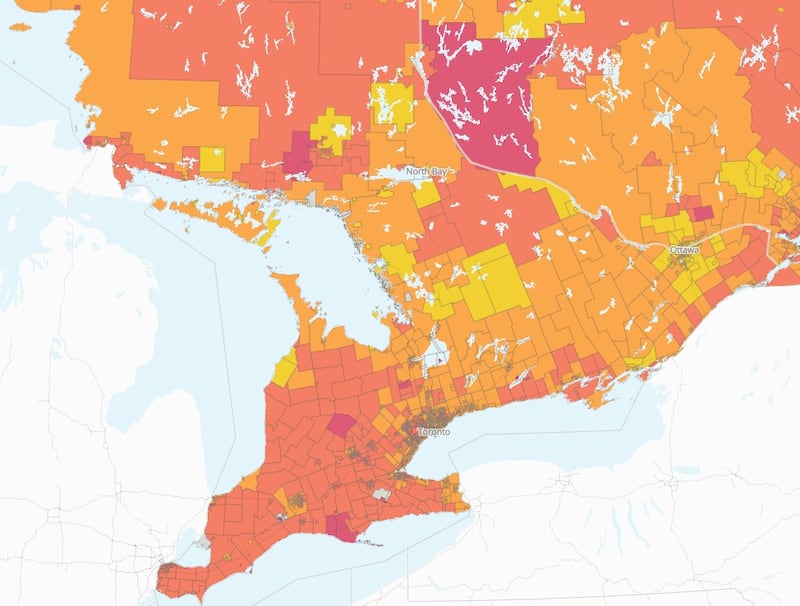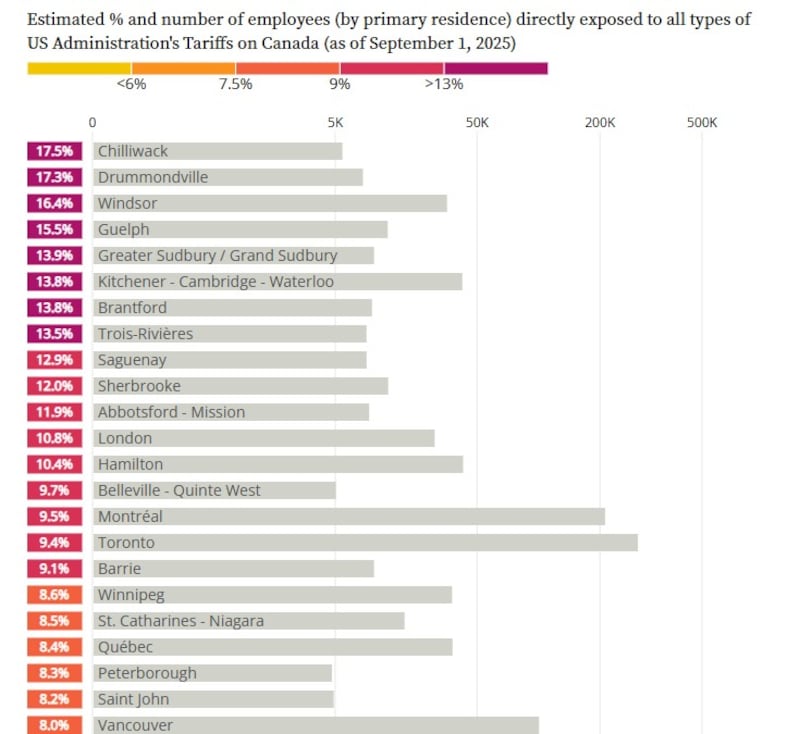A new tool unveiled by Toronto researchers is shedding more light on which towns and cities could be most harshly impacted by U.S. President Donald Trump’s tariffs on Canada, and the outlook for some Ontario towns is stark.
The research, recently unveiled by the University of Toronto’s School of Cities, aimed to provide a detailed view of the potential direct impact of U.S. tariffs on specific metropolitan areas. Researchers estimated the impact that tariffs on specific goods could have on jobs, businesses and residents in each area.
As part of the research, the team developed an interactive tool using data from Statistics Canada and other sources, allowing people to explore how specific U.S. tariffs on various sectors could affect Canadian cities.
“We thought it was really important to have a tool that was publicly available for policymakers and politicians and the general public to understand what that looks like,” said Dr. Tara Vinodrai, a professor in the Institute for Management and Innovation at UofT, who led the research along with Professor Karen Chapple, the director of UofT’s School of Cities.
Vinodrai explained that while much work has been done to assess the possible impact of tariffs on Canada’s economy as a whole, cities are where people could feel the impact most closely.
“The city is where people lead their everyday life. It’s where people work, it’s where people play. It’s where people engage in their everyday activities,” Vinodrai said. “And that’s really the scale at which we experience our lives the most – the city scale, the neighborhood scale. So I think it’s important to understand it in that way.”
‘Don’t think there’s a city or community that’s not affected’
Vinodrai said the research is somewhat surprising in terms of “how widespread” the potential impacts of tariffs would be. An interactive map predicts, in a granular way, where tariffs would be felt most closely. Zooming in, it shows that few parts of Ontario would remain untouched, especially Southern Ontario.
“I don’t think there’s a city or community that’s not affected in some way,” she said.
 Map Areas in pink show the places in Ontario where tariffs could impact the highest proportion of local populations (Screengrab/ University of Toronto School of Cities)
Map Areas in pink show the places in Ontario where tariffs could impact the highest proportion of local populations (Screengrab/ University of Toronto School of Cities)
According to the tool, three out of five of the local areas where employees most likely to be impacted by all tariffs reside are in Ontario – Windsor (16.4 per cent of workers who call the city home); Guelph (15.5 per cent); and Greater Sudbury (13.9 per cent).
Kitchener – Cambridge – Waterloo and Brantford came sixth and seventh on the list, meaning Ontario towns make up half of the top ten locations in Canada where it is estimated residents would be most directly impacted, as a percentage of the overall population.
In real numbers, Canada’s largest cities topped the list of places where workers likely to be most impacted reside, with Toronto coming in first place at just under 250,000.
While Montreal, Vancouver, Calgary and Edmonton rounded out the top five in terms of real number of residents estimated to be impacted, three Ontario cities were also in the top 10 list. They included Hamilton, Kitchener–Cambridge–Waterloo and Ottawa Gatineau – each with just under 50,000 residents likely to be directly impacted.
The tool can also be used to look at how many jobs and businesses would be affected in each area, and according to each industry.
 tariff local impacts A list of local areas in Canada where tariffs could impact the highest proportion of residents is shown. (Screengrab/ University of Toronto School of Cities)
tariff local impacts A list of local areas in Canada where tariffs could impact the highest proportion of residents is shown. (Screengrab/ University of Toronto School of Cities)
“The most obvious impacts, or the very visible ones, are in the sectors related to auto, and those sort of extend to then steel and aluminum as well,” Vindorai said, looking at the Ontario map.
In terms of the impact of the tool, Vindorai said she’s hoping it will help the public better understand the situation, but also to provide some insight for decision-makers in a visual way.
“There’s some lessons there for policymakers around diversifying,” she said.
The map could also be useful for helping to target hard-hit areas for assistance.
“I think our most important audience is a policy audience for helping understand the substantial scale and where there might be more important places for intervention policy and either programming and supports for particular communities,” Vindorai said.
She noted that the research did not explore the indirect impact that tariffs could have on jobs and workers in each area included in the study. She said that will be an area the team will explore in further research.
